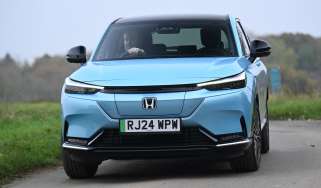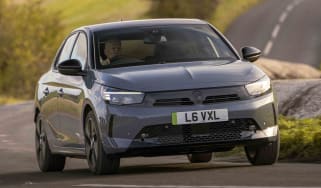Renault Scenic - Electric motor, performance & drive
Sure-footed handling isn’t fun, but the Renault Scenic does a decent job of smoothing out UK roads

Due to the smaller battery version being dropped from the Renault Scenic range, all models going forward come with an 87kWh battery and a 215bhp electric motor providing 300Nm of torque. Unlike its Nissan Ariya sibling, the Scenic is front-wheel drive only, which may be an issue for some who live in remote areas of the country susceptible to snow and ice in the winter and are looking for a Scenic with four-wheel drive. Renault has yet to add a four-wheel-drive option to any of its electric models.
| Model | Power | 0-62mph | Top speed |
| Renault Scenic Techno 87kWh | 215bhp | 7.9sec | 105mph |
What is the Renault Scenic like to drive?
There’s a sporty edge to the Scenic courtesy of its firm ride and fast steering, but it’s not a particularly agile car to drive.
In town
Light steering with a quick rack boosts the Scenic’s manoeuvrability at low speeds, but this is offset by a lack of all-round visibility. You sit low compared with some rival electric SUVs, while the rear window is narrow and the view is obscured by the large headrests in the back.
For those reasons, we’d recommend the top-spec Iconic Eprit Alpine model, because it comes with a 360-degree camera system and digital rear-view mirror, although this can be switched off if you prefer glass. All models in the line-up feature front and rear parking sensors.
Used - available now

2023 Audi
A1 Sportback
21,137 milesManualPetrol1.0L
Cash £16,690
2022 Volkswagen
ID.4
40,867 milesAutomaticElectric
Cash £16,994
2022 Peugeot
3008
62,532 milesManualDiesel1.5L
Cash £15,559
2024 Audi
A1 Sportback
33,557 milesManualPetrol1.0L
Cash £16,608The 215bhp electric motor offers reasonable responses away from the lights, but there isn’t the typical punch in the back that a lot of electric vehicles deliver. The Scenic now comes with a one-pedal drive mode like its Nissan Ariya sibling as part of the model range revisions. That means you can fully utilise the regenerative braking in stop-start traffic without needing to touch the brakes, making it a little more relaxing in town and helping to boost your overall efficiency and range.
On A- and B-roads
At motorway speeds, you’re aware that the Renault’s steering is relatively quick around the dead-ahead position and requires constant attention to ensure the car is tracking straight. This gives the impression that the Scenic has a sporty edge, but while the ride is on the firm side, that’s more to do with keeping the car’s weight in check than trying to deliver an engaging drive.
A sub-two-tonne kerbweight doesn’t sound all that special, yet in the world of electric SUVs the Scenic is one of the lighter models on sale. This helps with its responses, but there’s still some body roll in corners, while the firm suspension shudders over bumps that rivals can absorb easily. Some of that can be blamed on the 20-inch wheels that are standard on high-spec variants.
While the car’s power delivery isn’t as forceful as in some EVs, the Scenic’s front-wheel-drive set-up can still struggle to get it down, especially if you’re exiting a corner, when the inside wheel will break traction. Wheel-tugging torque steer is also an issue if you feed all of the power in at once.
On the motorway
Refinement at motorway speeds is good, and wind noise is reduced on top-spec Iconic models courtesy of standard-fit acoustic glass. There is some tyre roar to be heard instead, though.
0-62mph acceleration and top speed
Every Scenic comes with a 215bhp electric motor, allowing for a 0-62mph sprint in 7.9 seconds. Its top speed of 105mph is faster than a number of EVs, although you'll have to go abroad to find a road where it's legal to drive that fast, and it won't do your driving range any favours to travel at that speed.








